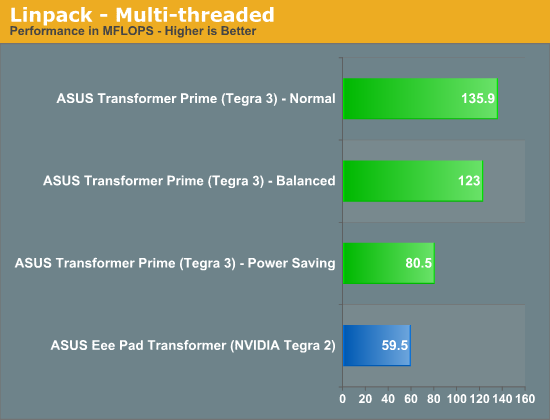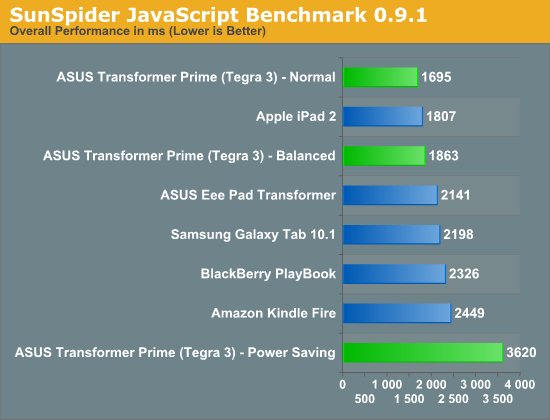ASUS Eee Pad Transformer Prime & NVIDIA Tegra 3 Review
by Anand Lal Shimpi on December 1, 2011 1:00 AM ESTCPU Performance
The big news with Tegra 3 is that you get four ARM Cortex A9 cores with NEON support instead of just two (sans NEON) in the case of the Tegra 2 or most other smartphone class SoCs. In the short period of time I had to test the tablet I couldn't draw many definitive conclusions but I did come away with some observations.
Linpack showed us healthy gains over Tegra 2 thanks to full NEON support in Tegra 3:


As expected, finding applications and usage models to task all four cores is pretty difficult. That being said, it's not hard to use the tablet in such a way that you do stress more than two cores. You won't see 100% CPU utilization across all four cores, but there will be a tangible benefit to having more than two. Whether or not the benefit is worth the cost in die area is irrelevant, it only means that NVIDIA (and/or its partners) have to pay more as the price of the end product to you is already pretty much capped.


The bigger benefit I saw to having four cores vs. two is that you're pretty much never CPU limited in anything you do when multitasking. Per core performance can always go up but I found myself bound either by the broken WiFi or NAND speed. In fact, the only thing that would bring the Prime to a halt was if I happened to be doing a lot of writing to NAND over USB. Keyboard and touch interrupts were a low priority at that point, something I hope to see addressed as we are finally entering the era of performance good enough to bring on some I/O crushing multitasking workloads.

Despite having many cores at its disposal, NVIDIA appears to have erred on the side of caution when it comes to power consumption. While I often saw the third and fourth cores fire up when browsing the web or just using the tablet, NVIDIA did a good job of powering them down when their help wasn't needed. Furthermore, NVIDIA also seems to prefer running more cores at lower voltage/frequency settings than fewer cores at a higher point in the v/f curve. This makes sense given the non-linear relationship between voltage and power.
From a die area perspective I'm not entirely sure having four (technically, five) A9 cores is the best way to deliver high performance, but without a new microprocessor architecture it's surely more efficient than just ratcheting up clock speed. I plan on providing a more thorough look at Tegra 3 SoC performance as I spend more time with a fixed Prime, but my initial impressions are that the CPU performance isn't really holding the platform back.










204 Comments
View All Comments
medi01 - Thursday, December 1, 2011 - link
So am I.But as I recently discovered, it's much easier to switch on tethering on my phone and connect via wi-fi than to swap sim card between devices..
It was hard for me to justify having 2 internet enabled sim cards, but it might be just me.
Kegetys - Thursday, December 1, 2011 - link
I find tethering to be a huge battery drain for the cellphone and it's usually not that practical either for anything else than occasional "emergency" use. But I have three sim cards from my carrier all with unlimited use anyway so I dont need to do any sim swapping. I guess if you need to pay extra for that then tethering is a reasonable alternative.MiSoFine - Thursday, December 1, 2011 - link
3 SIM cards with unlimited use for no extra cost? Who's your carrier? I was going to suck it up and pay AT&T the extra money for tethering, but if that's an option, I'll take it!Kegetys - Thursday, December 1, 2011 - link
> Who's your carrier?Saunalahti :)
medi01 - Thursday, December 1, 2011 - link
Hi,could you include "time it takes to fully charge" please?
On samsung tab it takes surprisingly long (about 4 hours) for some it might matter.
metafor - Thursday, December 1, 2011 - link
That's going to be true of any device that standardizes on a USB 2.0 connection -- which I think all Android tablets thus far use; it's just a different connector.iDevices sort of get around this by using a non-standard USB connection (up to 1A vs the standard 500mA) which is why it can charge faster.
It won't be until USB 3.0 becomes more common that charging speeds will really pick up.
Mugur - Friday, December 2, 2011 - link
Well, this is not quite right. My 2 phones have 1000mA chargers through USB even if the standard for pc is max 500mA. My Nook Color has a non standard but downwards compatible USB charger with around 1900mA.I agree though that the tablets recharge time is slow...
anandtech pirate - Thursday, December 1, 2011 - link
the PowerVR SGX 543MP2 is a beast. I still remember waaaay back when powerVR used to make pc graphic cards.Death666Angel - Thursday, December 1, 2011 - link
They still do Intel integrated graphics in the Atom, if I'm not mistaken. :-) They were the supplier of all Intel motherboard IGPs as well, though those aren't around anymore. :DPenti - Friday, December 2, 2011 - link
They were not the supplier of Intel's IGP's, only the Atom US15W/L/US11L one and some (not all) of the Atom integrated graphics in the CPU and in variants of SoC. Intel has made their own graphics since i740. Thus Intel GMA is their own tech. Own drivers. And so on. Only GMA500 and GMA600 (SoC), and newer GMA3600 and 3650, and likely GMA5650 in D2600/2700 is PowerVR. They don't have exactly excellent drivers for Windows and GNU/Linux desktops.GMA3150 is Intel, which runs in the latest Intel Atom N4XX and N5XX series, D4XX and D5XX.